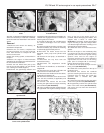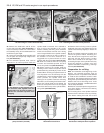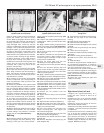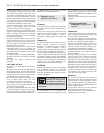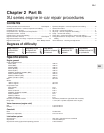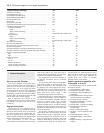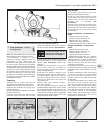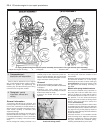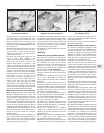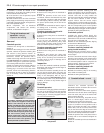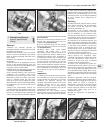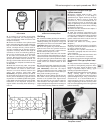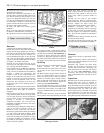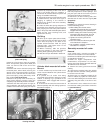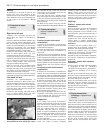
13 Slacken the two nuts on the front of the
timing belt tensioner and the single nut at the
rear. Use a spanner on the square end of the
tensioner cam spindle to turn the cam to the
horizontal position and so compress the
tensioner spring (see illustrations). Tighten
the cam locknut.
14 Remove the timing belt, taking care not to
kink it or contaminate it with oil if it is to be
re-used. Draw an arrow on the belt using
chalk to mark the running direction unless a
new belt is to be fitted.
15 Check the timing belt carefully for any
signs of uneven wear, splitting, or oil
contamination. Pay particular attention to the
roots of the teeth. Renew it if there is the
slightest doubt about its condition. If the
engine is undergoing an overhaul, and has
covered more than 36 000 miles (60 000 km)
with the existing belt fitted, renew the belt as a
matter of course, regardless of its apparent
condition. The cost of a new belt is nothing
compared with the cost of repairs, should the
belt break in service. If signs of oil
contamination are found, trace the source of
the oil leak and rectify it. Wash down the
engine timing belt area and all related
components, to remove all traces of oil. If the
timing belt is to be renewed, ensure that the
correct belt type is obtained - the timing belt
used with the earlier spring-loaded tensioner
is not interchangeable with the later type.
Models with eccentric roller tensioner
Note: Peugeot specify the use of special tool
(SEEM C. TRONIC type 105 or 105.5 belt
tension measuring equipment) to correctly set
the belt tension. If this equipment cannot be
obtained, an approximate setting can be
achieved using the method described below.
If the method described here is used, the
tension must be checked using the special
equipment at the earliest opportunity. Do not
drive the vehicle over large distances, or use
high engine speeds until the belt tension is
known to be correct. Refer to a Peugeot
dealer for advice.
16 Proceed as described in paragraphs 10
to 12, noting that the crankshaft pulley timing
dowel must be of 10 mm diameter, stepped
down to 8 mm at one end to engage with the
smaller hole in the timing recess.
17 Slacken the tensioner roller bolt to relieve
the belt tension, then withdraw the belt, noting
the direction of fitting and the markings. Take
care not to kink it or contaminate it with oil if it
is to be re-used. Draw an arrow on the belt
using chalk to mark the running direction
unless a new belt is to be fitted.
18 Examine the belt carefully with reference
to paragraph 15.
Refitting
Models with spring-loaded tensioner
19 Commence refitting by positioning the
belt on the crankshaft sprocket, then refitting
the pulley and verifying the correct position of
the crankshaft by means of the dowel.
Observe the arrows on the belt showing the
direction of rotation, and the timing lines
which align with marks on the crankshaft and
camshaft sprockets (see illustration).
20 Fit the belt to the camshaft sprocket,
round the tensioner and to the coolant pump
sprocket.
21 Release the tensioner cam locknut and
turn the cam downwards to release the
spring. Tighten the locknut and the tensioner
front nuts.
22 Remove the timing dowels and turn the
crankshaft through two full turns in the normal
direction of rotation. Turn the crankshaft further
to bring No 1 piston to TDC on the firing stroke.
23 Slacken the tensioner front nuts and the
cam locknut, then retighten them.
24 Turn the crankshaft further and make sure
that the timing dowels can still be inserted. If
not, remove the drivebelt and start again.
25 If a new belt has been fitted, it must be
run in and retensioned, as follows.
26 Tighten the crankshaft pulley bolt to the
specified torque, then refit and tension the
auxiliary drivebelt (see Chapter 1). Temporarily
refit the camshaft sprocket cover.
27 Run the engine up to operating
temperature, indicated by the cooling fan
operating, then stop it and allow it to cool for
at least two hours.
28 Rotate the crankshaft to the TDC position,
No 1 cylinder firing, then slacken and
retighten the tensioner nuts once more.
29 Remove the auxiliary drivebelt and the
crankshaft pulley. Refit and secure the plastic
covers, then refit the pulley and tighten its
bolts to the specified torque. Refit and tension
the auxiliary drivebelt.
30 Check the ignition timing and adjust if
necessary (Chapter 5B).
Models with eccentric roller tensioner
31 Commence refitting by slipping the belt
over the camshaft sprocket, followed by the
crankshaft sprocket, the coolant pump
sprocket, and finally over the tensioner roller.
Observe the arrows on the belt indicating the
direction of rotation, and the timing lines
which align with corresponding marks on the
crankshaft and camshaft sprockets.
32 With the camshaft timing dowel fitted,
rotate the tensioner roller anti-clockwise by
hand as far as possible to take up any slack in
the belt, then tighten the tensioner roller bolt
sufficiently to hold the roller in position. If the
special belt tension measuring equipment is
available, it should be fitted to the tensioned
run of the belt, and the tensioner roller should
be moved to give a reading of 30 ± 2 units.
Tighten the roller bolt to the specified torque,
taking care not to move the roller as the bolt is
tightened.
33 Check that the crankshaft and camshaft
are still positioned correctly by temporarily
refitting the crankshaft pulley and re-inserting
the timing dowel.
34 Remove the timing dowels, temporarily
refit the crankshaft pulley, and turn the
crankshaft through two full turns in the normal
direction of rotation. Check that both timing
dowels can still be inserted. If not, remove the
drivebelt and start again. Never turn the
crankshaft backwards during this procedure.
35 If all is well, remove the dowels, and turn
the crankshaft through two further turns in the
normal direction of rotation.
36 Refit the camshaft timing dowel, and check
that the belt can just be twisted through 90°
(using moderate pressure from the forefinger
and thumb) at the midpoint of the longest belt
run between the camshaft and crankshaft
sprockets. If in doubt about this setting, it is
better to err on the tight side until the tension
can be checked by a Peugeot dealer; if the belt
is too slack, it may jump on the sprockets,
which could cause serious engine damage. If
the special belt tension measuring equipment
XU series engine in-car repair procedures 2B•5
2B
4.13a Slacken the two nuts at the front of
the timing belt tensioner . . .
4.13b . . . and turn the tensioner cam
spindle to the horizontal position
4.19 Timing line on belt aligned with mark
on camshaft sprocket



